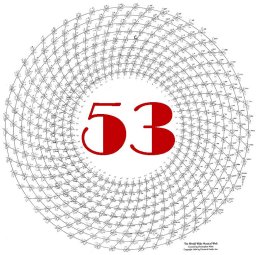Next Page: 11/4 – Condissonance
Chords in 12-eq and 53-eq
Most traditional chords and scales in our European tonal system are translatable from 12-eq to 53-eq. We’ll look at the Major and Minor scales, as well as triadic chords. We’ll touch on the seventh chords lightly, then study them in greater depth in Chapter 14.
Most triads (three-note chords) and seventh (four-note) chords have multiple possible versions in 53-eq. That’s because you are free to choose between Pythagorean and just tunings. Many theory books explain chords in terms of stacks of thirds, such as C-E-G-Bb. I think they are better explained using the harmonic lattice. Let’s look at a small piece of the lattice here and refer to it to describe our chords. As usual, we’ll hover in the neighborhood of C: Figure 11-1: A small lattice for chord-building (no sound)
| B2 — | F2# — | C2# — | G2# — | D2# — | A2# — | E2# — | B2# — | F2## |
| | | | | | | | | | | | | | | | | | |
| G1 — | D1 — | A1 — | E1 — | B1 — | F1# — | C1# — | G1# — | D1# |
| | | | | | | | | | | | | | | | | | |
| Eb — | Bb — | F — | C — | G — | D — | A — | E — | B |
| | | | | | | | | | | | | | | | | | |
| C1b — | G1b — | D1b — | A1b — | E1b — | B1b — | F1 — | C1 — | G1 |
| | | | | | | | | | | | | | | | | | |
| A2bb –- | E2bb –- | B2bb –- | F2b — | C2b — | G2b — | D2b — | A2b — | E2b |
Using the full lattice, you have infinite ability to play any scale or chord with any tonic or root note, because the pattern is always exactly the same. Since chords are built off of scale steps, we’ll start with the C Major and C Natural Minor scales and see how easy it is to find the notes of the G1b Major and Minor scales from there.
Here’s the C Major scale in both Just and Pythagorean versions:
Figure 11-2: C Major Scale in Just and Pythagorean measure 2243
The Pythagorean version sounds pretty close to what we’re used to hearing with a 12-eq piano. The ratios for the E (81/64) and the B (243/128) are hard for the ear to hear and almost impossible for the voice to sing. Even the pure fifths of 53-eq or pure tuning causes this scale to sound more nervous, challenging. The just C Major scale, with the much simpler ratios of the A1 (5/3), E1 (5/4) and B1 (15/8), is way more relaxing! You get to choose which version of the C Major scale you use; I pick one or the other depending on the subtle shade of expression I am looking for. A pastoral melody or a lullabye will definitely sound fantastic in just intonation. Sometimes, if I want a little bite, I’ll go with Pythagorean. I also honor the ancient musical systems, so if I am setting a Chinese text to music, I use 3-limit Pythagorean scales. Here’s what these C Major scales look like on the lattice:….
This is just the beginning of a detailed chapter on how chords sound different in 53-equal tunings. If you would like to learn more about this chapter, “Chords in 12-eq and 53-eq,” you can buy the entire book, The Grand Unified Theory of Music, in pdf form for $25 with hundreds of embedded musical examples of scales and chords from all over the world.
A free introduction to what The Grand Unified Theory of Music offers is on this website and includes both text and a few musical examples from each webpage. If you would like to learn more about this chapter and the full contents of this entire e-book, you can buy The Grand Unified Theory of Music for $25, with hundreds of embedded musical examples of scales and chords from all over the world — and ideas for how to set up your computer system —
HERE.
You’ll get a personalized password you can use to see the entire e-book. Inside the full book, you will also get a link to the complete pdf file of this e-book, which you can read on your Kindle or similar device. The links to the hundreds of mp3 sound files – the same ones you can hear on the website — will also be included. This is “Version 1.0” of The Grand Unified Theory of Music. Because it is an e-book, additions, corrections and improvements in the sound may be added at any time. The Grand Unified Theory of Music is Copyright © 2018 by Christopher Mohr. All rights reserved.
One person per password. Sharing this password with others is a violation of copyright. Do not allow others to use your password or link to the pdf file!
Next Page: 11/4 – Condissonance

